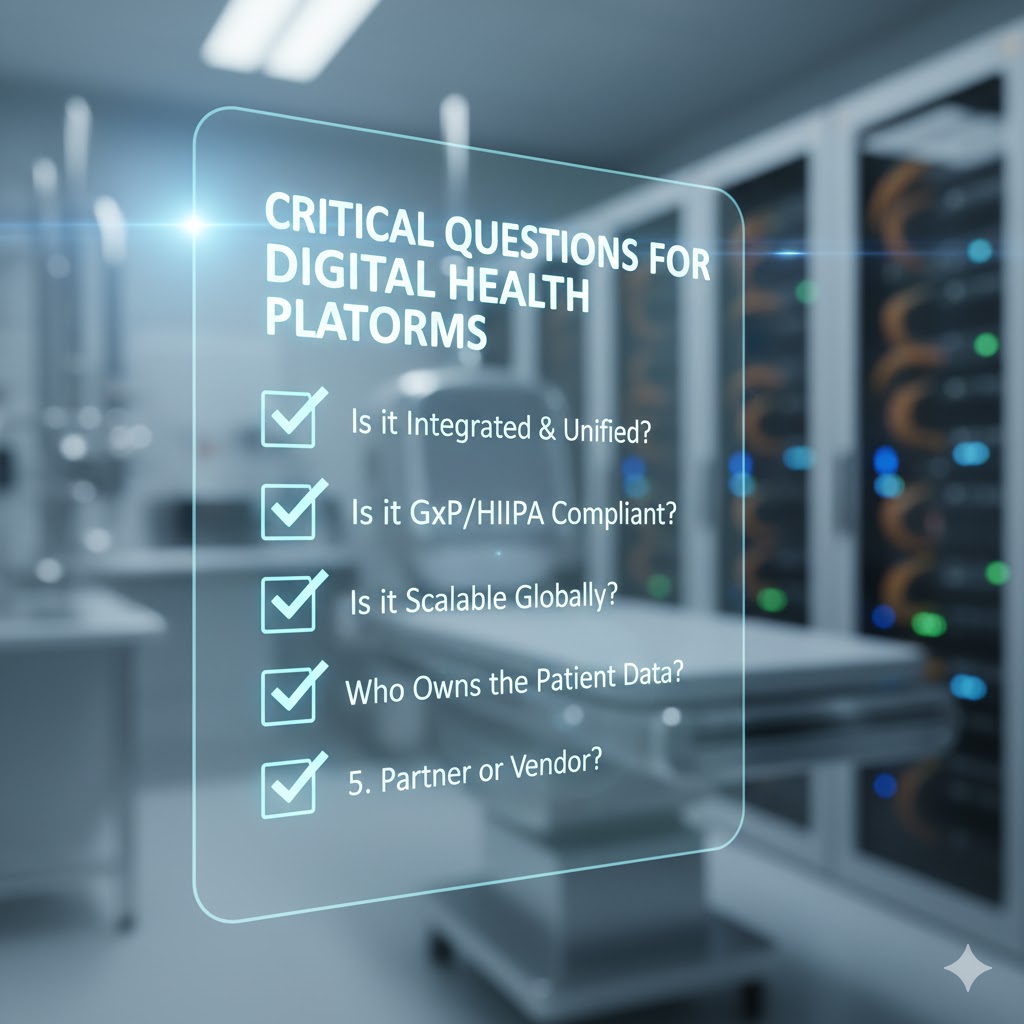Data Security Challenges in Digital Health and How to Overcome Them.
Introduction
The digitization of healthcare has transformed how medical professionals diagnose, treat, and interact with patients. Digital health technologies have made patient care more accessible, efficient and personalized than legacy healthcare practices. Electronic health records (EHRs), telemedicine, and wearable devices have improved patient outcomes and streamlined clinical workflows. However, the flip side is that digital health tools have also introduced alarming security risks.
Health data is perhaps the most sensitive of information, often containing personal identifiers, medical histories, and genetic information. This data is invaluable to those who perceive healthcare as a lucrative target for ransomware attacks, data breaches, and identity theft. Inadequate cybersecurity measures and the increased connectivity of devices have created these vulnerabilities.
The rise of cyber threats has mounted further pressure on digital health companies to take digital health data security very seriously. Lack of health data protection jeopardizes patient trust and exposes organizations to legal and financial issues.
To secure healthcare data privacy, healthcare providers, payers, and technology vendors have to implement targeted measures. Effective data protection requires a comprehensive understanding of the unique challenges that can compromise health data.
In this blog, we delve deep into the most pressing security challenges in digital health and look for strategies to overcome them. We’ll examine the technologies and best practices for safeguarding health data through encryption, access controls, and artificial intelligence-powered threat detection. Join us as we travel the multiple rungs of digital health security and uncover ways to protect patients and providers.
Data Security Challenges in Digital Health
The digital healthcare delivery modus operandi has made medical records, prescriptions, and patient data more accessible than ever and, consequently, more vulnerable to piracy. On one hand, digital health tools and technologies, like EHRs and telemedicine, offer unprecedented advantages in managing and personalizing patient care, and on the other, they invite threats to patient privacy and healthcare integrity. Digital health data security is therefore crucial when the stakes are so high.
1. Cyber Threats and Data Breaches:
The healthcare industry has become the prime target of cybercriminals due to the sensitive patient data that it banks and the criticality of its operations. In 2023, the healthcare industry reported data breaches costing an average of $10.93 million per breach. More findings show organizations that implement automation and AI cybersecurity enjoyed an average cost reduction of $1.76 million compared to those without such technologies. AI security and automation reduced the breach lifecycle by an incredible 108 days on average.
Data breaches in healthcare often involve information stored across multiple environments, such as public clouds, private clouds, and on-premises servers. This multi-environment storage approach reflects the complexity and varied data storage requirements of healthcare organizations. It also increases the challenge of securing this data. To maintain health data protection, investing in managed security services helps healthcare organizations maximize the effectiveness of their cybersecurity efforts.
2. Insider Threats and Human Error:
Employees or other insiders with access to healthcare systems may intentionally or unintentionally compromise data. This can occur through misuse of privileges, negligence, or malicious intent. Another insider threat is unauthorized access or data tampering. Human error, such as lost or stolen devices, misconfigured cloud storage, or weak passwords, accounts for threatened healthcare data privacy. As a 2022 global report on the cost of insider threats reveals, insider threat incidents have risen 44% over the past two years, with costs per incident up more than a third to $15.38 million.
3. Interoperability and Integration Risks:
The increasing use of Application Programming Interfaces (API), wearables, and IoT devices expands the surface of the attack. Integrating disparate systems and devices creates sensitivities in digital health data security. When health data is transferred between different systems and stakeholders, the threat of unauthorized access, data loss, or data infringement increases. Digital health providers must balance interoperability with the need for secure data transfer protocols. They have to ensure that patient information remains protected while collaborative healthcare efforts can continue unhindered.
4. Cloud Storage and Third-party Vendor Risks:
The global healthcare cloud computing market is projected to grow from USD 53.8 billion in 2024 to USD 120.6 billion in 2029. Cloud computing in healthcare refers to the use of cloud-based technologies to enhance the healthcare digital ecosystem. Cloud computing in healthcare provides innumerable benefits to both providers and patients, maximizing the benefits of digitalized healthcare. Cloud technologies are applied in healthcare fields, such as mobile apps, patient portals, electronic medical records, devices with the Internet of Things (IoT), and big data analytics.
With the abovementioned technological evolution come demands for healthcare cloud security, which safeguards data privacy across online infrastructure, applications, and platforms. This becomes a desperate need to vouchsafe the confidentiality and integrity of patient records, clinical applications, and valuable medical research data. Cloud security requires collaboration between cloud providers and their clients, including healthcare institutions, staff, and even the patients themselves.
5. IoT Device Security Concerns:
As the use of IoT healthcare devices continues to grow, more digital entry points become available for attackers. These are a constant threat to patient data and the overall network security of healthcare organizations. The reliance on supply chains introduces further security risks, as third-party vendors might not be maintaining similar stringent security protocols. Devices like smartwatches, health monitors, and remote sensors have limited security features, making them vulnerable to hacking. Ensuring security for these devices requires robust encryption, regular updates, and secure authentication measures. For digital health providers, managing the security of thousands of interconnected devices is a formidable yet essential task.
6. Compliance with Privacy Regulatory Frameworks:
It is mandatory for digital health platforms to be compliant with data privacy laws like the Health Insurance Portability and Accountability Act (HIPAA) in the United States and the General Data Protection Regulation (GDPR) in Europe. These regulations enforce stringent prerequisites for data handling, storage, and sharing. However, their complex structures become a deterrent for managing large volumes of patient data. It requires continuous updates to security protocols. Thus, the HIPPA compliance that is supposed to maintain healthcare data privacy becomes a challenge for global digital health companies operating across different regions.
Strategies for Overcoming Data Security Threats
Health data protection warrants effective data security as a compliance requirement and a patient trust imperative. By systemizing digital health data security, healthcare organizations ensure the confidentiality, integrity, and availability of sensitive patient information. Overcoming data security challenges in digital health requires a multi-pronged approach.
1. Implementing Strong Access Controls and Authentication Protocols: Only authorized personnel should have access to specific data, and multi-factor authentication (MFA) should be used to secure logins. Along with this, the implementation of the Principle of Least Privilege (PoLP) limits exposure and reduces the attack surface since users can only access data that is essential for their role.
2. Encrypt Sensitive Data at All Stages: Encryption ensures that data remains unreadable to unauthorized parties. It should be applied at all stages - be it at rest or in transit. Strong algorithms should be in place to prevent unauthorized access when at rest. In transit, Transport Layer Security (TLS) secures data exchanges between healthcare applications and systems.
3. Conduct Regular Security Audits and Risk Assessments: Healthcare organizations can identify technical vulnerabilities within their systems by conducting regular risk assessments. This gives them ample space and time to carry out targeted remediation. Implementing incident response plans in response to vulnerability scans and penetration testing should also be scheduled periodically.
4. Train Staff on Cybersecurity Best Practices: Human error is significantly responsible for compromising health data privacy. However, this can be mitigated by educating staff on cybersecurity best practices. These would include recognizing phishing attempts, proper password management, and secure handling of sensitive information.
5. Use AI and Machine Learning for Threat Detection: AI and ML algorithms can detect anomalies and patterns indicative of potential attacks. The use of AI-driven threat detection systems helps healthcare organizations respond to potential breaches without loss of time. This proactive approach helps to prevent small threats from escalating into full-blown security incidents.
6. Implementation of Regulatory Standards: Adherence to regulatory standards, such as HIPAA, GDPR, and CCPA, is a legal imperative. These regulations provide guidelines on handling patient data, including data minimization, patient consent, and security measures. Regular compliance audits help maintain robust security practices.
7. Establish Robust Data Back-up and Recovery Plans: A strong data backup and recovery plan is critical for controlling the impact of ransomware and other data loss incidents. Backing up data frequently and storing it in secure, off-site locations ensures that healthcare organizations can quickly restore information in the event of a breach or ransomware attack.
Emerging Trends and Innovations in Healthcare Data Privacy
The healthcare industry is experiencing a shift in the demands of data privacy and security. Emerging trends and innovations, driven by technological advancements, are prioritizing security, transparency, and patient control.
- Blockchain-based Data Sharing: Healthcare organizations can use blockchain technology to securely share medical records, track data provenance, and enable patient consent management.
- Artificial Intelligence-driven Privacy: This technology enhances the detection of real-time threats, incident response, and data anonymization.
- Zero-Trust Architecture: This assumes that all data access requests are potential malware. It verifies user identity, authenticates devices, and limits data access.
- Homomorphic encryption: This enables computation on encrypted data. It ensures secure data analysis, protected patient information, and compliance with regulations.
Conclusion
Healthcare data can be sustained and survive with consistent innovation, vigilance, and collaboration. Healthcare organizations have to be continuously up on technological advances to maintain patient trust, transparency, and security. No single solution can fully eliminate all the challenges that come with expeditious healthcare solutions. As the healthcare industry embraces digital transformation, its leaders, providers, and IT professionals must work together to anticipate emerging threats and cultivate a security-first culture.





